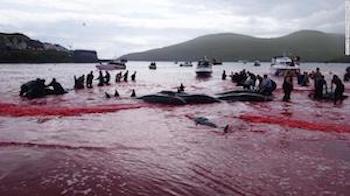The Grindadráp, Faroe Islands (a self-governing territory within the Kingdom of Denmark), present day:
The grindadráp (or “grind”) is a hunt that has no quotas, and no season. It is authorized any time a pod is spotted, and rarely denied – that being only when weather or sea conditions make it too hazardous for the boats. The hunt’s purpose is not to take live captives to drive big profits selling to the entertainment industry. The entire point of this activity is to kill.
After a pod is located, the Faroese drive the whales using recreational or fishing boats, or any other watercraft available (even jet-skis), including small boats launched from Faroese Coastguard vessels. Over several hours, they’ll create a ‘wall of sound’ from their engines to force the stressed and increasingly panicked pod towards the nearest designated killing bay. In the shallow waters Faroese men are waiting to rush into the water to kill the whales there, or to drag them further ashore with ropes and a type of hook called a blásturongul which is designed to be rammed into the whale’s blowhole. The men will sever the whale’s spinal cord with a lance resembling a short spear, then use a traditional grind hunting knife known as grindaknívur to cut through the whale’s neck.
Faroese government and media propaganda describes the killing of the dolphins and pilot whales as quick and humane. In reality, the Grindadráp often turns into a long drawn-out, disorganized massacre. With Faroese boats blocking their escape, the pilot whales and dolphins are killed in front of their relatives, often over long periods of time. All while beached on sand and rocks, or struggling to try to defend themselves in shallow water. Not one member of the pod is ever left alive.
Turning to the other side of the world – to Taiji, Japan – it’s easy enough to understand what happens every year between Sept 1st and March 1st. Simple greed will provide a sufficient answer, as the trade in live captures is lucrative. The large numbers killed instead of captured are targets of opportunity for ruthless men incapable of empathy for a fellow sentient species, eager to supplement their income a little more. And of course sadistic men will always be drawn to this kind of activity. But once the day arrives that the demand for dolphin shows dries up, so does virtually all of the profit from the Taiji drive hunts. For now, there will always be someone willing to commit these acts for the kind of money that’s involved. But long-term the whole operation, including the killing, makes little financial sense without the riches of live captures. The cost of maintaining a dedicated fleet, and all the supporting infrastructure, would be prohibitive, as dead dolphins really aren’t worth that much.
OK, so let’s look at the Solomon Islands, where dolphins have historically been killed for food. In a place marked by relative poverty and lack of economic opportunity, the rise of eco-tourism has offered a welcome replacement that has effectively made the dolphins far more valuable alive than dead. The killing today is about 10% of what it once was, and hopefully will soon be down to zero.
Now how about aboriginal subsistence hunts in the north of Canada, Alaska, Greenland and Siberia? These will be considerably harder to bring to an end, but the reasons they take place are easy enough to understand. Much more to be discussed on this topic in later posts, but for now suffice it to say that in aboriginal hunts the intent to inflict cruelty is not involved. The death of the animal is perceived as necessary for the survival of the human, and there is great respect bestowed upon the animal that provides that sustenance. Such hunts can’t end soon enough, but we need to recognize that they are substantively different from those taking place in the Faroe Islands.
Off the coasts of Peru or Nigeria, where dolphins are often seen as competitors for fishing resources, they are routinely killed (usually illegally) for perceived reasons of practicality. Using the flesh of an animal as smart as a dolphin to bait fishing hooks is obviously horrifying. But we can understand that the problem that needs to be solved is that circumstances will drive people of very limited means to employ the cheapest killing methods possible, regardless of the suffering inflicted on the dolphins.
OK, so let’s try the coasts of European nations such as France or the UK, where tens of thousands of dolphins per year die in fishing nets. It means someone didn’t care enough to bear the extra expense to prevent it. Dolphins are viewed simply as by-catch and a ‘cost of doing business’ by a callous industry that will one day be held to account when a more aware public refuses to buy a single fish until it can be properly certified that a dolphin hasn’t already paid for it with his life. Again, nothing difficult to understand here.
But Faroe? What the hell is this? What is really going on here? All killing of cetaceans must end, and in that sense the moral imperative for us is the same. But most of the time we can derive a rationale that motivates the killers. When we can understand the reasons any given slaughter happens, it gives us an opening to fight back. In every case above, with one exception, there is some aspect of supply and demand at play, which means we have a way we can work the problem. And eventually bring it to an end.
But the case of the Grindadráp has to be the most senseless of all. It is, in a word, inexplicable.
It looks like cruelty for its own sake. A blood sport or sick rite-of-passage for Faroese males. Theirs is a society rich in a material sense, but with a culture increasingly out of touch with Europe and the rest of the world. An embarrassment to the E.U. No one in the Faroe Islands is hungry and needs the meat to live. There is plenty of documented evidence of food rotting in dumpsters behind markets in the Faroe Islands. And this includes meat from the whales so cruelly slaughtered on their beaches.
The Faroese government and people seem to be impervious to pleas from the rest of the world. In fact, the considerable criticism directed their way only seems to strengthen their resolve. So it would appear that we can’t defeat the Grind by attacking it directly, as a sufficient number of the Faroese people simply don’t care what the world thinks.
But if we attack the problem indirectly, there is an economic incentive we should be able to use to drive home the need for change. We need to discourage tourism to their islands. And we need to avoid purchasing their exports (with fish making up 90%). When those are sufficiently impacted, we believe the Faroese will start to care what the world thinks of the Grind.
For The Orca’s Voice,
Phil, Canadian Cetacean Alliance



Leave a Reply